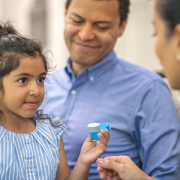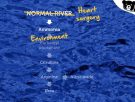A successful patient-centered asthma study

A study by Stephen Teach, M.D., M.P.H., shows that extensively engaging stakeholders such as parents, families and local service providers in study design can transform a planned research project into a more patient-centered study.
For hundreds of years, scientific and medical research has followed a process that practically all grade-school children learn as the scientific method: Scientists make observations that lead to a question. After developing a hypothesis, the researchers and colleagues — usually other scientists in the same field — test it by gathering data from experiments, making more observations or searching through the existing literature. Once they have an answer, the researchers often publish it in a scientific journal, which can generate new questions among peer scientists and starts the cycle all over again.
While most research is meant to benefit humankind as a whole, non-scientists and people who aren’t research subjects usually aren’t involved much in the process itself. That can be a serious omission, particularly for medical research, says Stephen J. Teach, M.D., M.P.H., chair of the Department of Pediatrics at Children’s National Health System, and Deborah Quint Shelef, M.P.H., C.C.R.P., AE-C., program director at IMPACT DC, a program at Children’s National Health System that helps patients effectively manage asthma.
“Our patients might view research a little differently than we do. They don’t just want general contributions to knowledge, but specific contributions that people can actually use,” Shelef says. “One of our main goals is to have useful research models that can translate into changes that really improve patient care. It’s hard to make this happen without asking people who are affected most what would address their needs.”
That’s why Shelef and Dr. Teach’s most recent study, featured on the cover of the December 2016 issue of The Journal of Allergy and Clinical Immunology, shifts the research paradigm from a scientist-centered model to what they call a stakeholder-centered approach. Rather than develop the study solely with fellow researchers, the research team led by Children’s National relied heavily on guidance from people who would be most impacted by the results.
The study focused on whether an intervention that reduced parental stress could improve asthma outcomes among low-income African American children. To help design their study, the research team looked to several different sources for advice: African American parents of children treated for asthma at Children’s National; local providers of social, medical, legal and educational services; and experts in psychosocial stress, medication adherence and conducting studies among at-risk youth with asthma.
The researchers gave themselves one year to consult multiple times with each stakeholder group before starting to enroll study subjects in May 2015. In the initial planning phases, the research team intended to focus their study on whether reducing parental stress would change how well children stuck to taking their asthma medications. However, that focus quickly changed, says Shelef. “Medication adherence just wasn’t a meaningful goal to most parents,” she explains. “To them, having more symptom-free days was a better gauge of how well an intervention was working for their children.”
The proposed intervention itself also transformed. Rather than focusing on problem-solving, cognitive-reframing and parenting skills — the researchers’ initial ideas — the final intervention would instead teach participants mindfulness, deep breathing, positive thinking, self-care and gratitude — as well as how to use these coping skills with their children. Rather than being staffed by social workers or psychologists, the stakeholders preferred people they felt they could relate to: Community wellness coaches with experience teaching yoga, meditation or other wellness activities in neighborhoods in which they lived.
Several other tweaks significantly changed the study from its early incarnation into the final version that the researchers are currently implementing, says Dr. Teach. “We ended up in a very different place from where we started based on this extensive process of stakeholder engagement,” he says.
Shelef notes that it’s not always feasible to involve stakeholders so heavily or to intensively plan a study for a year before it begins. Keeping all the advisers focused on the study at hand without radically changing the focus was a challenge, she says, and it was an “incredible scramble” in the end to translate all of their feedback into a cohesive product. However, having input from the people who could gain the most from the research results made it all worth it.
“The real benefit to this approach is the richness of the final product,” Shelef says. “Ultimately, this study will show a lot more than if we hadn’t put so much into it at the beginning.”











